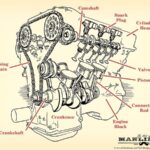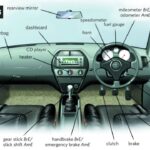When you’re aiming to refresh the appearance of a part of your car with a new coat of paint, it can be frustrating to find a noticeable line where the new paint meets the old. This demarcation, often appearing as a ridge or a color mismatch, can detract from the seamless finish you were hoping to achieve. Let’s delve into why these lines occur and how to effectively address them.
Over time, the factory paint on any Part Of A Car naturally undergoes fading and oxidation due to sun exposure and environmental factors. Unless the fading is severe, it’s often imperceptible until a fresh layer of paint is applied next to it. The stark contrast between the vibrant, new paint and the subtly aged original paint is the primary culprit behind those visible cut-off lines you’re noticing.
This effect can be particularly pronounced depending on your vehicle’s paint system. Many modern cars utilize a two-stage paint process involving a base coat for color and a clear top-coat for gloss and protection. If your original paint includes a clear coat and you haven’t reapplied a clear coat to the touched-up part of the car, the difference in sheen and protection can further emphasize the paint line. Conversely, older vehicles might feature a single-stage paint system with a thicker base coat, which can also contribute to noticeable lines if not blended correctly.
To effectively diminish or completely eliminate these contrasting lines and achieve a smooth, blended finish on the affected part of your car, the key lies in a process known as cutting and polishing. This involves carefully leveling the boundary between the new and old paint layers.
For this task, it’s generally recommended to use separate cutting and polishing compounds rather than a combined “cut and polish” product. Fresh layers of automotive paint and clear coat tend to be relatively thick, requiring a more aggressive cutting compound to effectively even out the height difference with the surrounding original paint. A cutting compound works by gently abrading the paint surface, leveling imperfections.
It’s important to understand that cutting compounds often leave behind a微hazy or dull finish. This is where a pure polishing compound (not a glaze or wax) comes into play. The polishing compound refines the surface after cutting, restoring gloss and clarity to the paint, effectively removing the hazing and revealing a smooth, seamless finish on the treated part of your car.
The polishing process can be performed either by hand or with a machine polisher. While hand polishing is feasible, it can be time-consuming and may result in imperfections like swirl marks or holograms, especially on larger areas. Dual Action (DA) polishers are generally considered safer for car paint and minimize the risk of damage or burning through the paint, making them a popular choice for professionals and enthusiasts alike.
However, for a small spot repair on a part of your car, hand polishing is often a practical and cost-effective solution. Investing in a machine polisher might not be justifiable for minor touch-ups, especially considering their price point. By carefully hand polishing the area, you can effectively blend the new paint with the old, achieving a much less noticeable transition and a more visually appealing repair.

